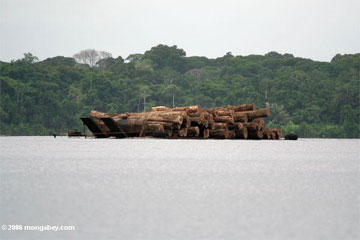China to push for sustainable logging overseas
China to push for sustainable logging overseas
China issues guidelines for sustainable forest plantations abroad
Rhett A. Butler, mongabay.com
April 25, 2007
In a surprising move, China has developed guidelines for the establishment of sustainable forest plantations abroad by Chinese firms, according to the International Tropical Timber Organization’s (ITTO) April 1 Tropical Timber Market Report. The move comes as China faces increasing criticism from environmental groups for pillaging the world’s forests to feed its rapidly growing economy.
The State Forestry Administration will soon begin the process of selecting companies to implement the guidelines, which include bans on illegal logging and clearing of natural forests for plantations, on a “trial basis,” according to ITTO.
The guidelines are significant as China plays an increasingly important role in resource extraction in forests around the world. Chinese firms are aggressively investing in oil palm plantations in Indonesia and logging operations throughout Asia and Africa.

|
China’s interest in foreign timber jumped dramatically following a domestic ban on logging after deadly flooding in 1998. Politicians blamed deforestation for the damage wrought by the floods.
The sustainable forest plantations initiative follows the announcement of a government “green buying” policy last December. Starting in 2008, the policy will prioritize purchasing of environmentally friendly products and services. by state and provincial governments.
Related articles
China's demand for hardwood drives illegal logging says Greenpeace — 4/17/2007
Environmental group Greenpeace said on Tuesday China should take responsibility for illegal hardwood logging in Southeast Asia which supplied the raw materials for Chinese exports to the West.
China needs 5 million cubic meters more of tropical timber by 2010 — 10/16/2006
China needs 5 million cubic meters more of tropical timber by 2010 according to the September 15-30 ITTO Tropical Timber Market Report, a publication published by the International Tropical Timber Organization. China is already the world's largest consumer of tropical wood, importing more than twice the volume of tropical logs as India, the second largest importer on the list.
China's timber imports surge in 2006 — 5/21/2006
According to China Customs, China's timber imports surged during the first quarter of 2006. Log imports increased 18 percent to 8.1 million cubic meters. China customs valued these imports at $897.42 million. Most of the log imports (64 percent) consisted of softwood logs from Russia. Sawnwood imports amounted to 1.45 million cubic meters worth some $385.72 million. Separately, the ITTO Tropical Timber Market Report reported that paper multinationals are aggressively investing in China's paper industry.
China's Olmypics may destroy New Guinea's rainforests — 5/1/2006
Construction for the 2008 Olympics in China may fuel deforestation in New Guinea according to an article published last week in the Jakarta Post. The article reports that a Chinese company has asked the Indonesian government for permission to establish a timber processing factory in Indonesia's Papua province to produce 800,000 cubic meters of merbau timber in time for the Olympic games to be held in Bejing. Merbau — a dark hardwood found in the rainforests of New Guinea — is used for hardwood floors and currently commands prices of up to US$138 per square meter, making the proposal potentially worth more than a billion dollars.
Timber hungry China moves into Africa — 4/20/2005
With its projected growth rates, China will soon surpass the United States in wood consumption. This voracious appetite for timber is threatening tropical forests around the globe but nowhere is this more apparent than in Africa where China is increasingly focusing its development efforts and adding fuel to a booming trade in illegally harvested timber.
Chinese economy drives road-building and deforestation in the Amazon — 4/17/2005
Chinese economy drives road-building and deforestation in the Amazon







